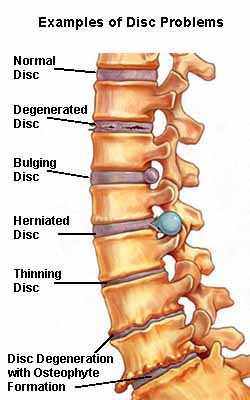There are thousands of people that suffer from the pain and discomfort caused by degenerative disc disease. Some people with this medical condition do not even notice much discomfort at all. However, there are numerous others suffering from DDD that may find it hard to even get out of bed each morning. This is a condition that can affect a person’s neck or the cervical area of the spine, the middle back or thoracic area of the spine, or even the lower back, which is the lumbar area of the spine. There are some people that only suffer the symptoms of degenerative disc disease in only one portion of the spine. There are also others that suffer chronic pain from DDD in all areas of their spine. It is however a condition that is most common in the lumbar region of a person’s spine.
Causes of DDD or Degenerative Disc Disease
The spinal discs in a person’s back begin to degenerate or break down as they begin to grow older. While not everyone experiences problems with back pain, some people will start to notice the signs and symptoms of degenerative disc disease as they age. There are certain changes that often take place in the spine when this occurs and they are as follows:
- A bulging or ruptured disc – This is when the nucleus, which is a jellylike substance in each disc, begins to seep out of cracks or small tears in the capsule (annulus), or outer layer of a disc. This is a problem that can cause a person’s disc to bulge, rupture, or even burst into small fragments.
- Decreased disc fluid – When this occurs the space that is normally between the vertebrae can narrow and the disc itself can become thinner. A much lower amount of flexibility generally occurs because the shock absorbing action that the fluid provides to the discs is decreased.
When a person suffers an acute or sudden injury to the back which causes a disc to rupture, it will sometimes start the process of disc degeneration. Degenerative disc disease is a condition that is most often suffered in people that are obese, people that smoke, and those that that engage in rigorous and repetitive physical labor.
Common Symptoms Experienced with Degenerative Disc Disease
The symptoms that DDD can cause can vary a great deal from one person to another. A lot of people have degenerative disc disease and do not even realize it because they don’t experience any pain or discomfort. Others with the very same amount of damage may experience a tremendous amount of neck or back pain. In many cases it will interfere with the person’s ability to take part in even the simplest of activities.
The specific area that is generally what determines the location of pain that a person will experience. When discs are bulging or ruptured in the neck, a person may feel pain in their neck, or they may only feel pain in the arms. The lower portion of the spine can result in pain that radiates from the low back all the way down the individual’s leg. DDD also commonly causes numbness in the limbs as well.
There are numerous treatment options that are available today for people that suffer the pain, frustration, and even depression that DDD can cause. These can include various types of medications, injections into the spinal canal, physical therapy, the use of a tens unit, and numerous other options.











